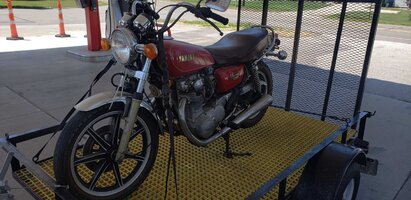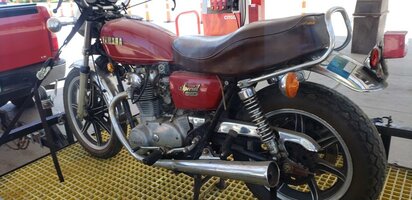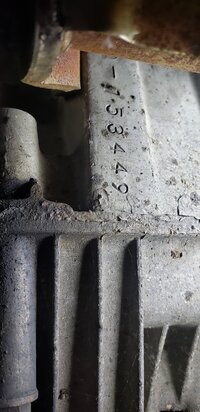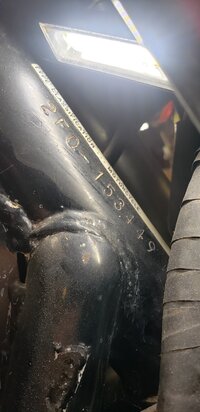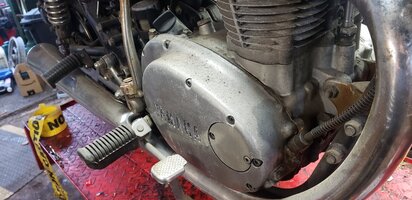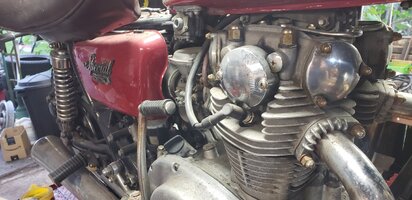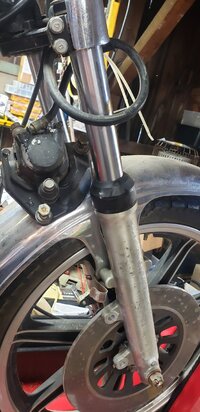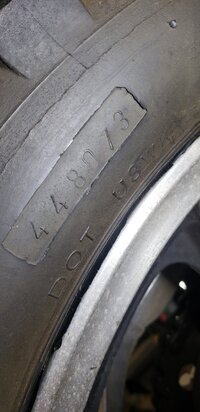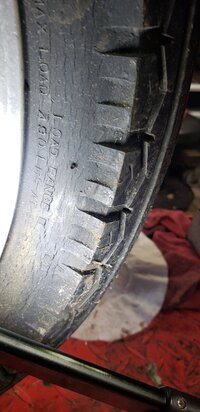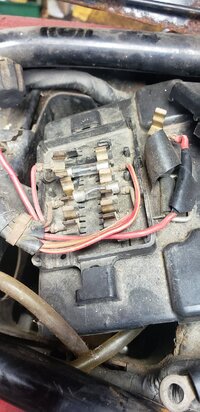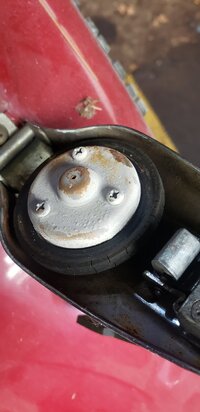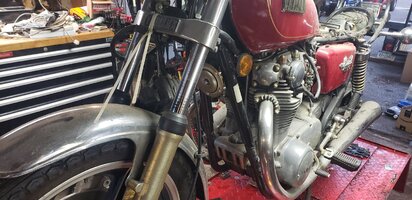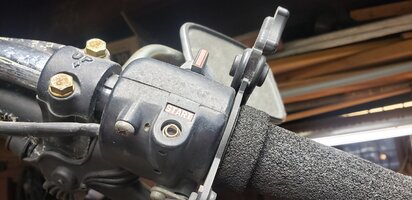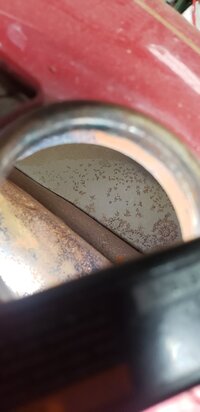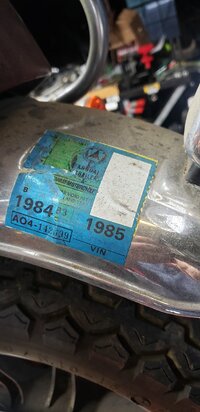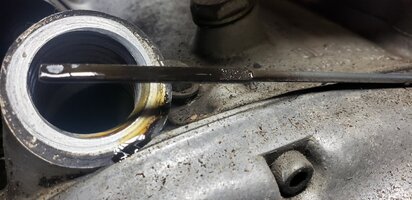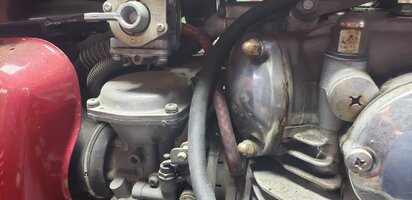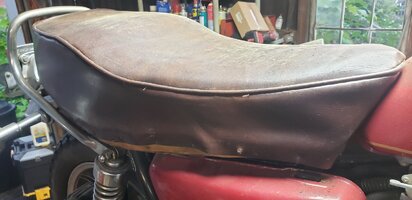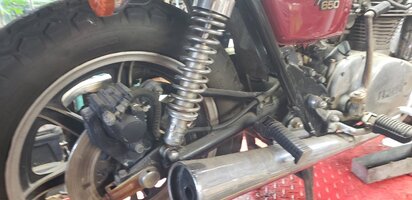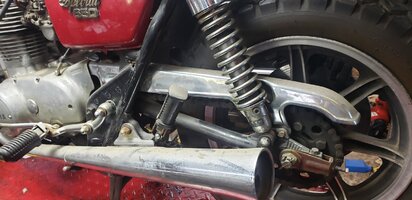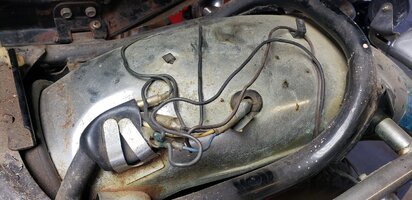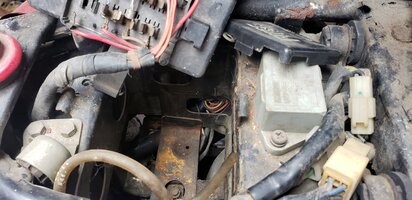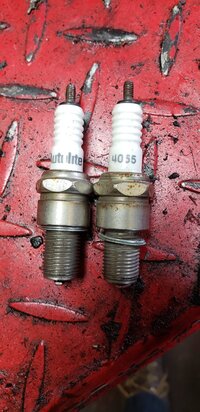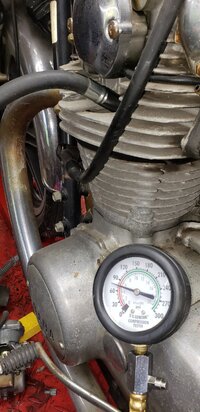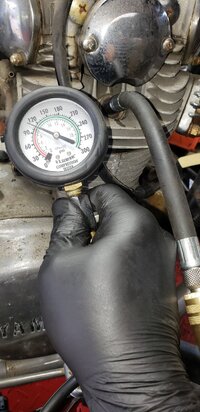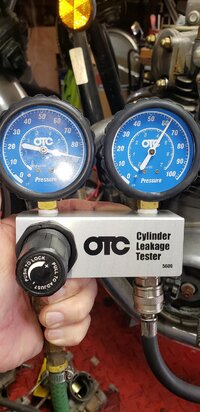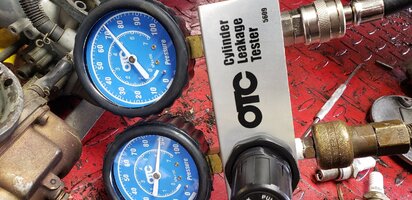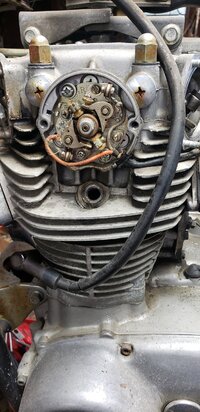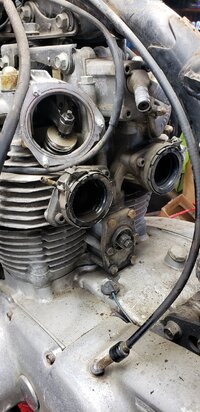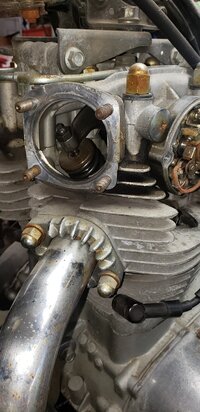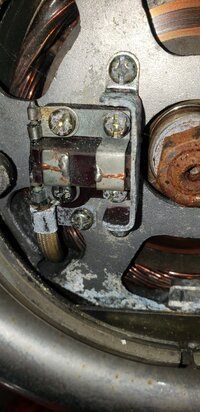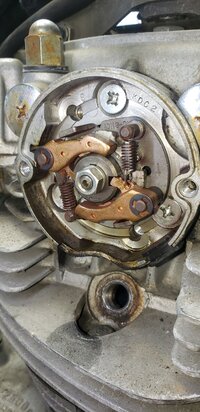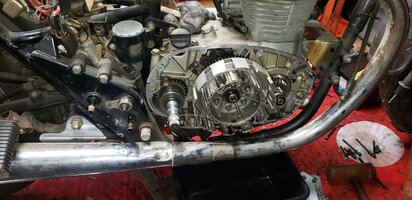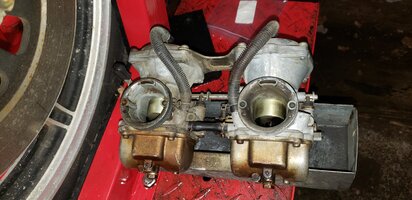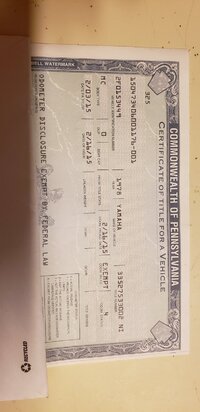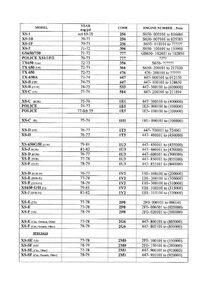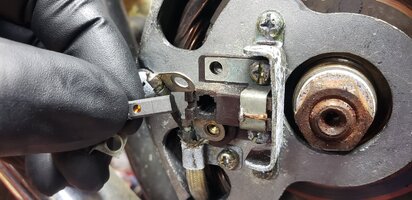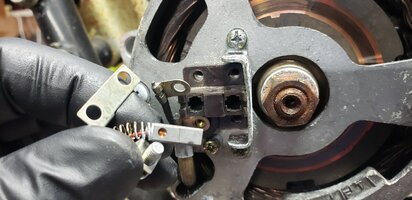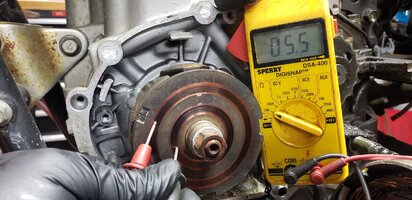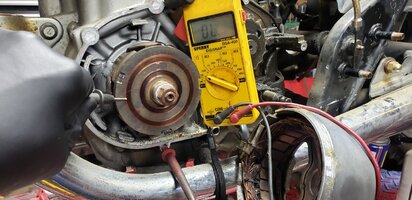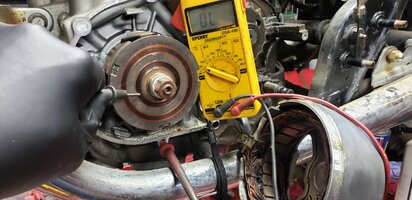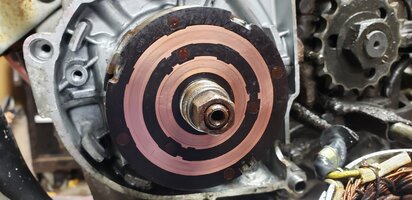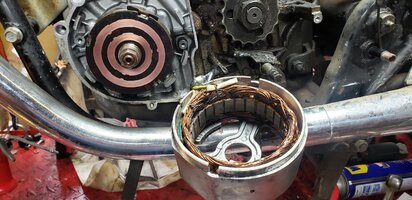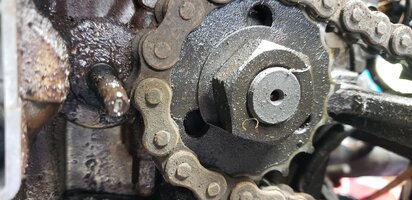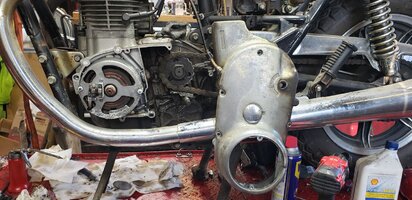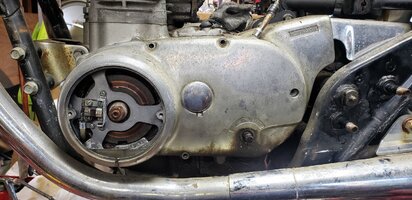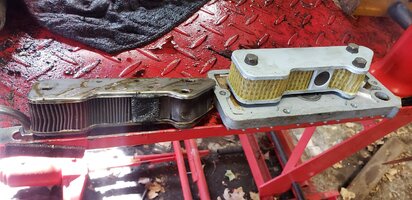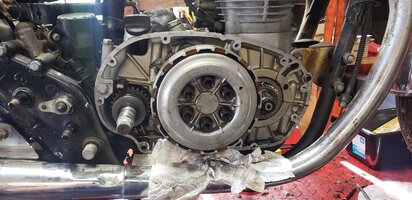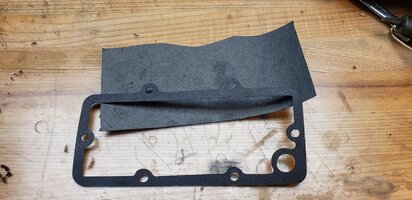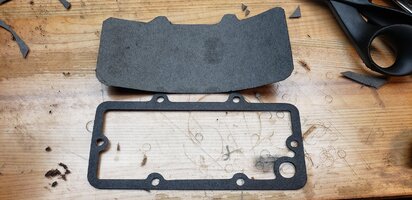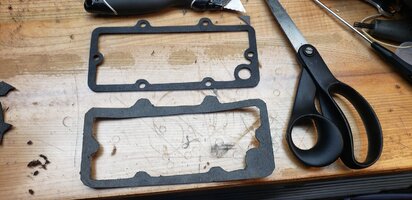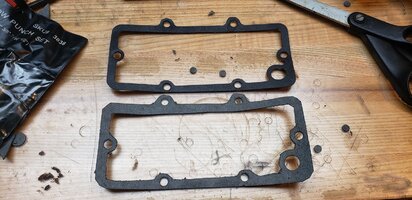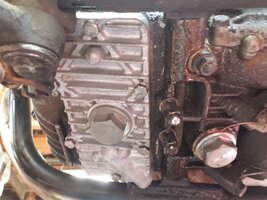On to the next day. The air box comes off and I notice it's missing both access doors, filters, the rubber crossover boot is basically dust, and the right side battery box/airbox mount is gone. I dig through my spare parts and I find the mount and both doors. I put the rubber boot on order from MikesXS, and the air filter elements are out of stock. No biggie. I also order the two little rubber cushions that the side cover hangs on. The right sides are there, lefts are missing.
The carbs come off next. The slides aren't stuck and the butterfly valve operates. Nice. Set them aside for rebuild later.
Now onto checking compression. Pushing the kickstarter through a couple of rotations reveals good compression. We shall see. Remove the plugs, which were hand tight, and find they are Autolite 4055? Maybe just stuck in there to prevent water getting in and rusting? If so, it worked. But new plugs go on my order.
I pull out my "General *something*" Chinese compression tester out of its case, and screw in the appropriate adapter into the left plug hole and pop the quick-connect onto it to connect the gauge. Using a 12V battery, I clamp the ground onto the frame an touch the other clamp to the starter side of the solenoid. Away she spins without protest and it reads... 70 psi. Uh oh. I know a good engine will show 150+ psi. I squirted some oil down the hole and went over to the right side. 110 psi. Double uh oh. I squirt some oil down that hole and go back to the left side. I spin the starter again and I notice I can feel the rubber hose of the tester pulsing on each compression stroke. Then I remembered I used this tester on a known good engine and got low readings on that also. I think the hose is absorbing some of the compression by bulging instead of passing it to the gauge. I got another tester I have and try again. 140 psi on the left and 160 psi on the right. Good numbers, but too much discrepancy between the two sides.
I break out my leak-down tester, hook it to the left cylinder and crank the pressure up to 90 psi, and I can hear and feel a rush out the right intake port. My back pressure gauge shows about 62 psi, so more than 30% leak down. Not real bad, but not right. I take out my plastic mallet, remove the lash adjustment cover and whack the rocker arm a few times and I get about 72 psi back pressure. 19% leak down. Better, but not good enough. I rotate the crank to get the intake vale open, squirt some WD40 onto a soft bristle bottle brush and scrub the valve face and the valve seat as best I can through the plug hole and the intake port. After getting everything our of the cylinder with a towel and compressed air, I try again and I get 5% leakdown, which is acceptable. A compression test shows 155 psi on the left cylinder. There was some rust and/or carbon holding the valve open slightly, and the brush and WD40 dispatched it.
I check valve lash and the intakes are a little tight and exhausts are a little loose. I make the adjustments because I'm picky.
Checking the centrifugal advance, I find it sticking, so I pull off the weights and remove the shaft, and reassemble using a dab of light grease. that seems to have fixed that, we'll see with the timing light when I get it running. While apart, I take the points cam to a wire wheel to knock off the little bit of rust on it.
Next, I drain the oil and pull the sump cover off to inspect the suction screen. The screen is surprisingly intact. I fired up my ultrasonic cleaner to get it warmed up for the sump cover and other parts to follow. Next off come the right footrest, kickstarter lever, and brake lever so I can pull the right side cover to check the clutch. I notice a lot of grunge around the kickstart shaft, so I add a seal to my order. After removing the right side cover screws, I rap the cover a little with my plastic mallet, and the cover comes loose, but rips the gasket. Add a gasket to the order. I use an impact driver to loosen the clutch screws (I order the allen screw kit for the clutch) and pull the clutch plates. Clymer's manual says the plates should be .140" with a .122" lower limit. All my clutch plates measure .120". I happen to have a new set of clutch plates on hand, and they measure .118". I consult my Yamaha manual and it specifies .118" with a .106" lower service limit. My Haynes manual says likewise. If you just have a Clymer manual, ignore the clutch plate thickness spec. My clutch is perfectly good. I'm still considering pulling the clutch hub and basket to check the thrust bearing and make sure it all looks good, but, honestly, everything looks and feels good. I may still do it to check that the shift lever pawls at the shift drum are centered. It'll depend on what mood I'm in when I go out there to do it. It appears the engine has not been opened since new, so since I don't have to worry a "Bubba" has had his dirty dick beaters all over everything buggering it all up, I may just put the clutch back together and button it up when I get the gasket. Sorry to my friends not in the US, we still use the barbaric inch system. We had the chance to get our act together in the late 70's and adopt the metric system, but for whatever reason, we failed.
I did clean the sump cover, and I fit a new screen to it before putting it back on the engine case. I cleaned the right side cover inside and out, and had the oil pump apart and all looks good there. The right side cover is waiting for the gasket and kickstart shaft oil seal, and that can go back on.
The pics are in random order, but you can understand the context of most of them from the text above.
Next, I'll reassemble the clutch, then set the points and static timing, check the alternator brushes, the rotor resistance, the stator resistance, replace the pushrod bushing and seal, and then probably start rebuilding the carbs.

